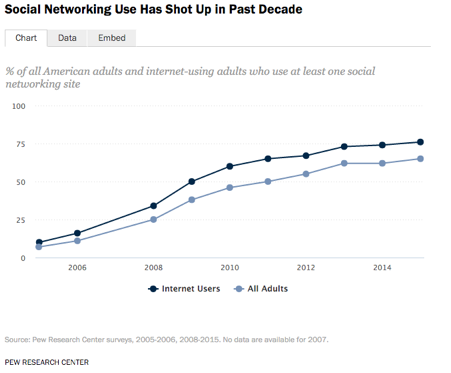I’ve read a few blogs recently that have been reflecting on the idea that business websites are becoming a thing of the past. It’s an interesting idea, considering the spread of other mediums to interact with your customers.
It’s true that in days gone by if you wanted to find info about a company on the web you went to their website. There was, actually, nowhere else to go, so websites ruled the roost. Mind you a lot of sites were not the most appealing places to visit. But that didn’t really matter.
Then things changed, there was the mobile revolution and social media revolution, both almost at the same time.
Mobile Revolution
Let’s look at the mobile revolution first. Back in 2008 Mary Meeker predicted “Mobile to overtake fixed internet access by 2014”. It might have seemed like a bold prediction back then. But guess what — it happened. The mobile revolution is not a future event, it’s in the past. It’s now a historical fact. Have a look at the graph below.
We are now in an era where there are more mobile users of the internet than desktop. So ignore mobile users at your peril!
Still need to be convinced? Have a look at this graphic…
As you can see, most web users in the US spent the majority of their digital time on mobile as compared to Desktop.
The Social Media Revolution
Ok so we need a mobile friendly website – you knew that already! That’s the easy part! The secondary issue for website owners is that the mobile revolution has been combined with the social media revolution. Social media usage has exploded since 2008, helped in no doubt by the rise of the smartphone and mobile apps.
76% of all US internet users are now using at least 1 social media account. With the rise of social media has come the rise of businesses using social media to interact with their customers and why not? It is a fantastic way to engage directly with your customers. In fact 63% of millennials say they stay updated on brands through social networks. So again, as business and brand owners we ignore social media at our peril.
So what about the humble website?
Back to the small business website. Is there really a need for a website if your customers are accessing you via Facebook, Twitter or another social media outlet? Is it safer to just forget about it and concentrate on social media instead? After all, you don’t pay hosting fees, design fees or worry if you have forgotten to renew your domain name every year!
Well I don’t think so. In fact I think that by overlooking your website you’re missing a massive opportunity. Yes mobile is here to stay and yes the social media revolution is here for good — embrace it with open arms. And yes your web strategy will need to change. A static website that hasn’t changed in 6 months just doesn’t cut the mustard anymore, even if you have an active Facebook feed. When a customer lands on your website and sees that all the content is old and stagnant, that’s bad for your reputation and bad for business.
The key thing to remember about your website is that it really is the only place on the net that you actually own and therefore control. Yes you can control what you post on Social Media, but after that you have really no input. You can’t decide who sees it and how those customers experience the interaction or what competitors they may be exposed to.
But you can control everything on your site. Once a customer lands on your site, you can decide what products they are directed to, what their experience is like, and you can be constantly testing and refining your offering to discover how to improve your conversion rates. You can collect email addresses. You can do whatever you like — it’s yours, and nobody will be trying to take a cut of your profits either.
So instead of it becoming outdated, it needs to become a hub. A place where all your social media outlets are brought together. A place where all your customers land no matter how they initially connected with you. Think of a wheel with many spokes — your website is the hub. The spokes can be many different things such as social media, ad campaigns, physical marketing products, etc. but all spokes must lead to the hub.
It is also useful to know that desktop and tablet are still the places where conversion rates are the highest. So use that advantage effectively.
Conclusion
So do I think that the website for SME’s are dead? No way, but they are changing. It’s time to get with the flow and have a modern, updated and connected site.
Nigel J.
WP Hero (wphero.io)
wphero.io helps individuals and businesses transform their WordPress websites into modern, connected web hubs. Contact us or sign up today.
Share This Post






